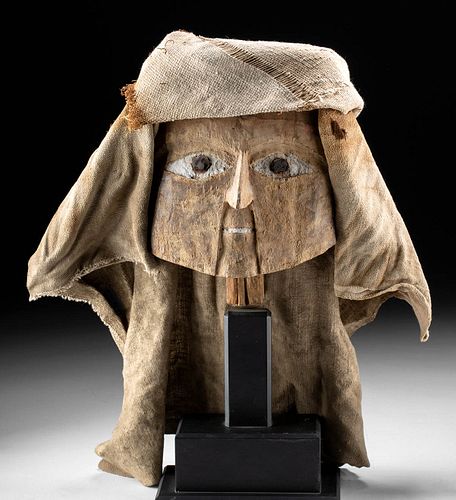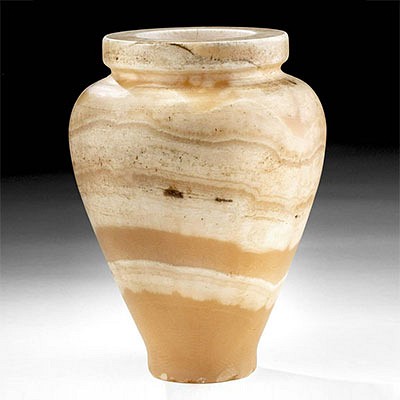Chancay Wood Mummy Mask w/ Textile Headdress
Lot 95a
About Seller
Artemis Gallery
686 S Taylor Ave, Ste 106
Louisville, CO 80027
United States
Selling antiquities, ancient and ethnographic art online since 1993, Artemis Gallery specializes in Classical Antiquities (Egyptian, Greek, Roman, Near Eastern), Asian, Pre-Columbian, African / Tribal / Oceanographic art. Our extensive inventory includes pottery, stone, metal, wood, glass and textil...Read more
Estimate:
$2,000 - $3,000
Absentee vs Live bid
Two ways to bid:
- Leave a max absentee bid and the platform will bid on your behalf up to your maximum bid during the live auction.
- Bid live during the auction and your bids will be submitted real-time to the auctioneer.
Bid Increments
| Price | Bid Increment |
|---|---|
| $0 | $25 |
| $300 | $50 |
| $1,000 | $100 |
| $2,000 | $250 |
| $5,000 | $500 |
| $10,000 | $1,000 |
| $20,000 | $2,500 |
| $50,000 | $5,000 |
| $100,000 | $10,000 |
| $200,000 | $20,000 |
About Auction
By Artemis Gallery
Dec 17, 2020
Set Reminder
2020-12-17 10:00:00
2020-12-17 10:00:00
America/New_York
Bidsquare
Bidsquare : VARIETY SALE | Antiquities & Ethnographic Art
https://www.bidsquare.com/auctions/artemis-gallery/variety-sale-antiquities-ethnographic-art-6207
Featuring classical antiquities, ancient and ethnographic art from cultures encompassing the globe. Egyptian, Greek, Roman, Etruscan, Near Eastern, Asian, Pre-Columbian, Native American, African / Tribal, Oceanic, Spanish Colonial, Russian, Fossils, Fine Art, more! Artemis Gallery info@artemisgallery.com
Featuring classical antiquities, ancient and ethnographic art from cultures encompassing the globe. Egyptian, Greek, Roman, Etruscan, Near Eastern, Asian, Pre-Columbian, Native American, African / Tribal, Oceanic, Spanish Colonial, Russian, Fossils, Fine Art, more! Artemis Gallery info@artemisgallery.com
- Lot Description
Pre-Columbian, Central Coast Peru, Chancay, ca. 1000 to 1250 CE. An anthropomorphic wooden mummy mask with painted details and a hand-woven textile headdress. The wooden mask is comprised of a short neck that supports the broad panel of wood carved with facial details such as a protruding hook nose, large diamond shaped eyes, and a thin mouth. The eyes and mouth are painted with white and black pigments, and the rest of the surface would have been painted red, a color of purity in Chancay burial rituals - note that small traces of the red pigment remain on the brow and cheeks. The textile on the head is tightly woven with beige threads and areas of fine gauze-like patterns. A stick pin holds the textile in place near the back. The material is perhaps wool from a camelid animal, such as an alpaca, an invaluable source for the rich textile traditions of the Andean cultures. The sober visage and generic features are part of the traditional mask style for adorning the mummified bodies, as they were not intended to be portraits, but a stylized representation the human face for important individuals as a mark of their elite status. After death, the status as deity was often bestowed upon these individuals and the mask became their permanent face. This mask, stunning and hauntingly staring outward, was created to last for eternity to receive the prayer and worship of ancestors. Size: 9.5" W x 10" H (24.1 cm x 25.4 cm); 17" H (43.2 cm) on included custom stand.
The arid deserts that surrounded the homeland of the Chancay culture facilitated the natural mummification of deceased animals and humans, perhaps leading the Chancay to embrace the dried preservation of their dead, since embalming fluid was not necessary. They incorporated elaborate textiles into mortuary rituals and often wrapped the body in cloth after it was positioned in a seated or fetal position with the head resting on the knees. The mask created a face for the mummy to direct worship, but it was often placed on the top of the wrappings and might not actually rest where the head was positioned.
For a stylistically similar piece see the Kroller Muller Museum accession number: 121.253
Provenance: ex-Steve Berger collection; ex-Arte Textil, San Francisco, California, USA active 1960s to 1990s
All items legal to buy/sell under U.S. Statute covering cultural patrimony Code 2600, CHAPTER 14, and are guaranteed to be as described or your money back.
A Certificate of Authenticity will accompany all winning bids.
We ship worldwide and handle all shipping in-house for your convenience.
#159179Desiccation of textile with fraying, unraveling, staining, and discoloration to textile commensurate with age. Expected surface wear to wood mask. Painted pigments remain and great details!Condition
- Shipping Info
-
All shipping is handled in-house for your convenience. Your invoice from Artemis Gallery will include shipping calculation instructions. If in doubt, please inquire BEFORE bidding for estimated shipping costs for individual items.
-
- Buyer's Premium



 EUR
EUR CAD
CAD AUD
AUD GBP
GBP MXN
MXN HKD
HKD CNY
CNY MYR
MYR SEK
SEK SGD
SGD CHF
CHF THB
THB

















